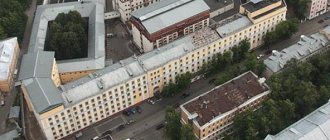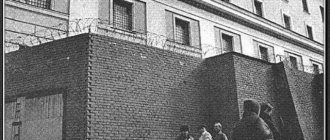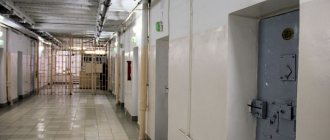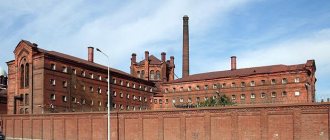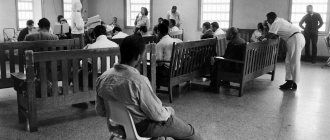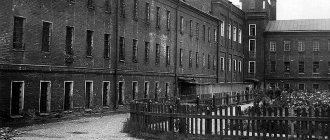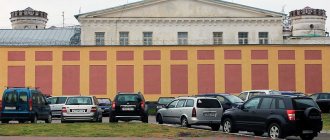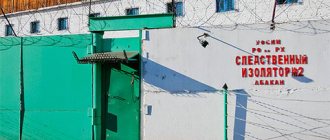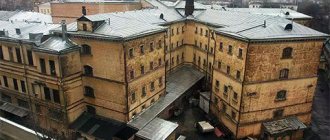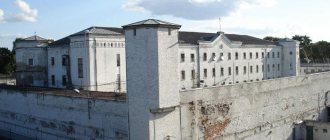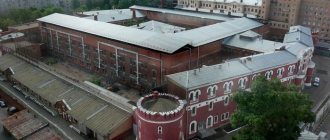Prison "Matrosskaya Tishina", located near the center of Moscow. It received its unofficial name from the name of the street on which it is located. Throughout the history of its existence, the isolation ward has been reconstructed and reorganized several times. Constant scandals and famous personalities who served sentences in “Matrosskaya Tishina” made this prison one of the most famous, not only in the Russian Federation, but also in other countries.
One of the most famous reasons why the detention center is known in European countries is the imprisonment of all members of the Emergency Committee. Today, according to official data, the cell area is at least 12 square meters, and each of them contains no more than 4 prisoners. In fact, the number of arrests is much higher.
Statements from relatives
To hold a meeting with prisoners of the Matrosskaya Tishina detention center, relatives must submit an application in the prescribed form. Based on the submitted application, permission to conduct a visit will be issued. Mandatory requirement for a document allowing a citizen to enter a meeting with a convicted person:
- Assigned outgoing number, which must be registered with the prosecutor's office.
- Date of receipt of permission.
The issued permit is valid for 30 calendar days.
Your own fence
When the conversation turns to places of deprivation of liberty, the first thing that comes to mind is a certain area, fenced with a high fence with an invariable decoration of barbed wire. In the case of the “Matrosskaya Tishina” pre-trial detention center, such an idea turns out to be not entirely true.
View this post on Instagram
A post shared by Victor Ray (@v1cr4v)
Photo of the “Matrosskaya Tishina” pre-trial detention center.
View from above Of course, there were some “thorns”. But the matter is not limited to the fence as a fence. It is enough to look at any photo of a pre-trial detention center taken from above to be convinced: the building itself, shaped like a trapezoid, partially replaces all sorts of other fences, representing a kind of barrier that prevents prisoners from escaping.
Transfers
The time for receiving deliveries to prison inmates is strictly defined - every Sunday from 9.30 to 14.00. Each year, no more than six transfers can be made to a prisoner, one transfer every two months. The weight of each of them is limited and should not exceed 20 kilograms. Prisoners who are kept in a reduced regime have the right to receive parcels every month. If it is revealed that a prisoner has received a prohibited item, disciplinary measures will be applied to him. It is allowed to send parcels to a prisoner. The total weight of all parcels should not exceed 30 kilograms per month.
Dating
Current legislation allows no more than two visits with each prisoner per month. To obtain permission to hold a meeting with a convicted person, it is necessary to prepare the relevant documents in advance. They must indicate who will meet with the arrested person. The following time has been established for drawing up and agreeing on the required package of documents:
- Monday to Thursday 9.30 – 16.00
- Friday 9.30 – 15.00
- Saturday and Sunday 09.30 – 14.00
- Documents are not processed every last Monday of the month - sanitary day
Persons under the influence of alcohol or drugs and those who refuse to present a document confirming the citizen’s identity are not allowed to visit. The staff of the pre-trial detention center immediately stop the visit if the rules of its conduct are violated. All appointments take place on a first-come, first-served basis. Every prisoner serving a sentence under general conditions has the right to a long visit, which is organized once every three months. For prisoners who have been transferred to a softer regime, they have the right to hold long meetings, once every two months.
The entire date takes place in a special, separate room. There is a fee for renting a room. The start time for a long date is 9 am. No more than two visitors are allowed to a prisoner at a time. This number includes all visitors, including teenagers and minors. If the visitor leaves the room, the date is considered over for him. On the same day, you are not allowed to re-enter the visiting room. Every prisoner has the right to negotiate and meet an unlimited number of times with his own lawyer. The maximum time for such a meeting is limited and is no more than four hours.
Prison Breaks
June 5, 1995
Killer Alexander Solonik escaped from prison.
The estimated time of escape is around midnight. The killer was assisted by a junior police sergeant.
Together with the prisoner, they climbed to the roof of the building and were able to descend using a fixed climbing cord.
March 13, 2003
During the morning check, Alexey Dyulger was not found. He was convicted of theft. A soft mode of detention was chosen for him. He worked as a cleaner in the utility room and, as a result, had access to a number of office premises. He was found on the prison grounds, hiding in the sanitary inspection room.
In September 2003, Vasily Slavgorodsky escaped. He was able to break through the brick wall that separated the exercise yard from the outer fence. After that, he jumped over the fence and disappeared. He was detained only in May 2004.
On May 2, 2004, Alexander Ershov escaped. He escaped while walking. He was able to knock out the brickwork of the wall of the exercise yard, then he penetrated onto the roof of the warehouses of the pre-trial detention center, which was located quite close to the main fence. After that, he jumped over the fence and disappeared. But he was detained 2 days later in the Lyubertsy district of the Moscow region.
May 7, 2013
Oleg Topalov escaped. He was able to make a hole in the chamber shelf.
How and what to get there
Sailor's silence, the pre-trial detention center is located near the center of the capital. The address of Matrosskaya Tishina can be found on the official website of the detention center. It is located on the street of the same name, house 18. The nearest metro station is Sokolniki. From the metro station to the detention center, there are various types of public transport:
- Tram No. 4L
There is a tram stop number 4L in the immediate vicinity. You need to get off at the stop called “Malaya Ostroumovskaya”, which is separated from the metro station by one stop. There is still a 650-meter walk to the pre-trial detention center.
- Bus routes No. 14 and 41
You need to get off at the stop called “Korolenko Street”. To get to “Matrosskaya Tishina” you will have to walk 550 meters. The total travel time from the metro station to the detention center is approximately 10-15 minutes
- You can get to Matrosskaya Tishina on foot from the metro station using the following route:
- Coming out of the metro, turn right and move along Barbolina Street. At the first intersection we turn left, where 2nd Boevskaya Street is located.
- We cross the street called 1st Boevskaya and turn right into a lane called Stromykinsky
- We move left along the street with the same name Matrosskaya Tishina to house 18
The approximate travel time from the metro to the pre-trial detention center on foot is 20-25 minutes. In the immediate vicinity of the isolation ward, there is a railway platform called “Elektrozavodskaya”, which is located within walking distance from “Matrosskaya Tishina”.
Have a question for a lawyer? Ask now, call and get a free consultation from leading lawyers in your city. We will answer your questions quickly and try to help with your specific case.
Telephone in Moscow and the Moscow region: +7
Phone in St. Petersburg and Leningrad region: +7
Free hotline throughout Russia: 8 (800) 301-39-20
Why is it called that?
The history of the name of one of the most famous pre-trial detention centers in Russia dates back to the times of Peter the Great. By order of Peter I, on the site of a modern pre-trial detention center, a building of a sailing factory and a sailor's settlement was erected to house workers. Due to the current situation, the enterprise itself was moved to another area, and the empty building was re-qualified as an almshouse for veteran sailors.
To create optimal living conditions for sailors, the movement of all types of transport and carriages was prohibited near the building. This area created rare conditions for Moscow, with a fairly low level of extraneous noise. Residents of the capital began to call this place Sailor’s Silence, after which this street received the official name “Sailor’s Silence”. Moscow pre-trial detention center No. 1 received its name from the name of the street on which it is located.
Story
At the first stages of its creation, the building simultaneously housed a camp and a home for the elderly, the so-called Charity House. The main contingent of prisoners held in prison were petty thieves and swindlers. Over time, the city grew, and the prison grew along with it.
During the revolution of 1917, the prison blocks were completely looted, and already in 1918, the new leadership of the country transformed the former prison. From this moment, the Reformatory began its work here. It was intended for criminals over 21 years of age. The main task of the new facility is the re-education of criminals who have committed the first serious offense in their lives. The establishment existed in this form for one year and was closed.
Until 1945, a tannery colony for criminals under the age of majority was organized at the facility. The colony was disbanded, and the facility was transferred to the Moscow Ministry of Internal Affairs. The pre-trial detention center in its modern form was organized in 1946.
Photo
The following are photos of the Matrosskaya Tishina prison:
Work on reconstruction and transformation of the facility
In 1947, there were 2 buildings on the territory of the prison. These buildings could accommodate up to 200 prisoners. In addition to these buildings, a boiler room operated on the territory of the prison. This boiler room is still in operation today. In addition, the following structures were located on the territory:
- Outbuildings.
- Administrative building.
- Barracks for staff.
The prisoners took walks in the utility yard. There were specially equipped sites there. They had an oval shape and were surrounded by a wooden fence. The prison was guarded by the Bogorodsk division of Moscow.
The third building was built in 1949. The building had a special entrance. It led to the territory from the side on which psychiatric hospital No. 3 was located. This prison was popularly called “sharashkin’s offices”, because scientists were kept here who, even while in prison, continued their scientific activities.
At the beginning of the 1950s, the administrative buildings were reconstructed. The number of floors in sensitive facilities was increased. It was from that time that buildings 1 and 2 have 5 floors. Walking yards were built on the roofs of these buildings. Prisoners still use these courtyards today.
Who is detained in “Matrosskaya Tishina”
The Matrosskaya Tishina detention center houses prisoners of various categories - from ordinary to very famous. Criminals accused of various charges, including serious crimes, are sent to serve their sentences in pre-trial detention centers. The terms of detention of prisoners range from very short to life. The Sailor's Silence detention center is a place where detained and under investigation citizens await their verdict. After a conviction, some categories of prisoners are transferred to other colonies in various regions of Russia.
Modernity
Today, the Matrosskaya Tishina prison is conditionally open to representatives of the media and various public organizations. From time to time, excursions of sorts are held there to show the life and living conditions of prisoners.
Naturally, during such events, visitors are shown the best cameras, recreation areas, and so on. In contrast to this, from time to time there are reports in the media about violations of the rights of prisoners, non-compliance with detention standards, hunger strikes, riots, escape attempts, deaths and other unpleasant moments, which allow us to judge that not everything is so smooth in pre-trial detention center No. 1. Moreover, such disadvantages observed not only from the prisoner side. So, about a year ago, information appeared that a reduction in the staff of the Federal Penitentiary Service led to their significant reduction. This gave rise to concerns on the part of the guards of pre-trial detention center No. 1. As employees of the penitentiary service admitted, due to the reduction in the number of guards, it became simply dangerous to work.
In such conditions, it becomes clear that many more years will be spent on bringing the state of Russian prisons to world standards.
Famous personalities of the detention center
Within the walls of the pre-trial detention center, a large number of famous personalities served their sentences, including:
- Hired killer who made three successful escapes from a pre-trial detention center - Alexander Solonik
- One of the most famous thieves in law nicknamed Yaponchik - Vyacheslav Ivankov
- The founder of the most famous financial pyramid MMM is Sergei Mavrodi
- Active member of the CPSU - Valery Boldin
- The organizer of the terrorist attack at the Cherkizovsky market is Oleg Kostyrev
- Marshal of the USSR, who served as Minister of Defense - Dmitry Yazov
- The head of YUKOS is Mikhail Khodorkovsky
Schedule
The requirements for prisoners of the Matrosskaya Tishina detention center do not differ from the generally established procedure. General rise is 6.00, bedtime is 22.00. During the day, prisoners are strictly prohibited from sleeping or resting on the bed. When the time for getting up and going out is approaching, the prisoners are notified with a special sound signal. The approximate daily routine of prisoners serving sentences in “Matrosskaya Tishina” is as follows:
- 30 breakfast, the menu of which consists of first, second and tea
- Every prisoner has the right to take water procedures for 15 minutes, once a week.
- Daily walks for an hour on a special area
- The lights in the cells are never turned off. After lights out, the lighting is switched to night mode
- Every day, pre-trial detention center employees make a tour of each cell, during which prisoners can ask their questions, express complaints or wishes.
Notable prisoners
| The list of examples in this article or its section is not based on authoritative sources directly about the subject of the article or its section. Add links to sources that cover the topic of this article (or section) as a whole, containing these list items as examples. Otherwise, the section may be deleted. This mark was set on August 27, 2022 . |
There is a widespread misconception that members of the State Emergency Committee and Khodorkovsky were kept in “Matrosskaya Tishina”. In reality, these and many other persons who required enhanced supervision were kept in a centrally subordinate pre-trial detention center located on the same territory - the current FKU pre-trial detention center No. 1 of the Federal Penitentiary Service of Russia.
- Maxim Sergeevich Martsinkevich
- Adamov, Evgeniy Olegovich
- Bagirov, Eduard Ismailovich
- Baklanov, Oleg Dmitrievich
- Barkashov, Alexander Petrovich
- Boldin, Valery Ivanovich
- Boyko-Velikiy, Vasily Vadimovich
- Bykov, Anatoly Petrovich
- Varennikov, Valentin Ivanovich
- Gaiser, Vyacheslav Mikhailovich
- Grushko, Viktor Fedorovich
- Derevyankin, Andrey Nikolaevich
- Ivankov, Vyacheslav Kirillovich
- Kavkazsky, Nikolai Yurievich
- Kostarev, Oleg Vladimirovich
- Kvachkov, Vladimir Vasilievich
- Kovalev, Valentin Alekseevich
- Konstantinov, Daniil Ilyich
- Kryuchkov, Vladimir Alexandrovich
- Lebedev, Platon Leonidovich
- Lukyanov, Anatoly Ivanovich
- Mavrodi, Sergey Panteleevich
- Magnitsky, Sergei Leonidovich
- Mironov, Ivan Borisovich
- Petrenko, Igor Petrovich
- Podrabinek, Alexander Pinkhosovich
- Polonsky, Sergey Yurievich
- Rubanov, Andrey Viktorovich
- Serebrennikov, Kirill Semenovich
- Solonik, Alexander Viktorovich
- Starodubtsev, Vasily Alexandrovich
- Ter-Petrosyan, Levon Akopovich
- Urlashov, Evgeniy Robertovich
- Udaltsov, Sergey Stanislavovich
- Khodorkovsky, Mikhail Borisovich
- Shenin, Oleg Semenovich
- Sherstobitov Alexey Lvovich
- Shirshov, Konstantin Vladimirovich
- Shutov, Yuri Titovich
- Yumatov, Georgy Alexandrovich
- Yazov, Dmitry Timofeevich
Time to work with citizens
You can prepare documents for a visit according to the approved schedule:
- Monday – Thursday from 9.00 to 16.00
- Friday – Sunday from 9.00 to 14.45
Submitting applications:
- for the current day from 9.30 to 11.15
- the next day from 13.00 to 16.00
Reception of citizens
- from Monday to Thursday from 9.00 to 18.00
- Friday from 9.00 to 16.45
Break for receiving citizens every day from 13.00 to 13.45
Conditions of detention
Conditions for life prisoners
Conditions for life-sentence prisoners are not the best. The prison is currently overcrowded, with prisoners having to sleep in three shifts. There are quite a large number of people in the cells.
Conditions for long-term prisoners
According to rumors, Khodorkovsky was in a cell measuring 12 square meters. There were also three other inmates in the same cell.
But not everyone is so lucky; mostly those who are sentenced to long imprisonment are in more cramped conditions.
